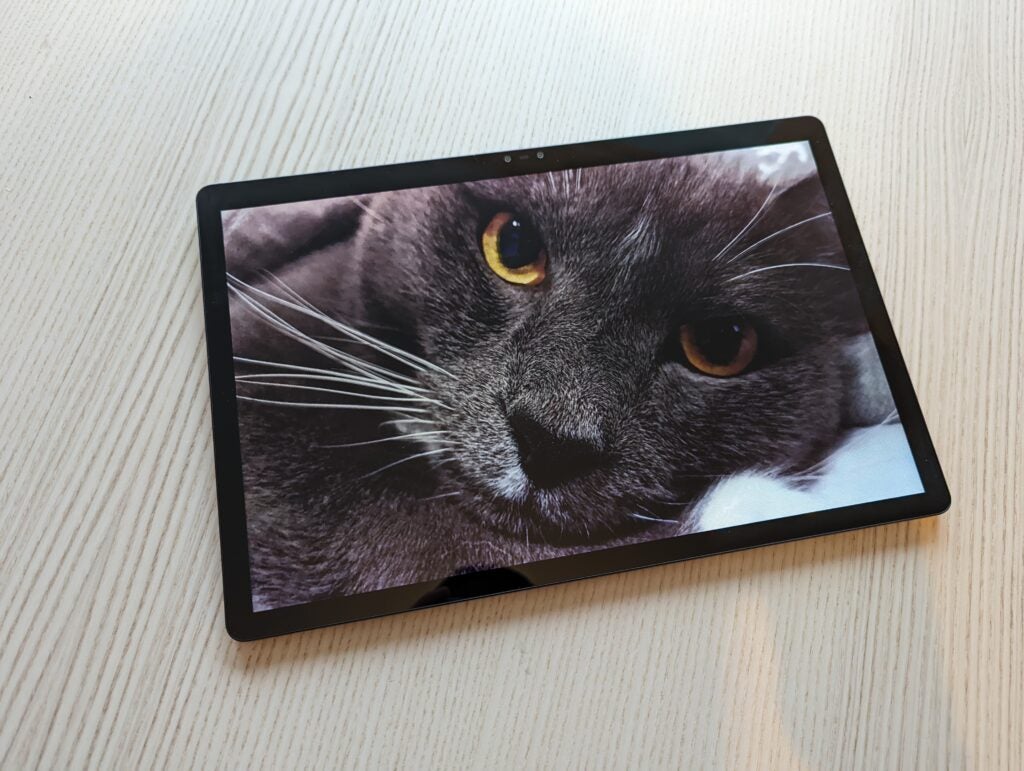The Nubia Pad 3D tablet is a party pleaser thanks to its remarkable 3D technology and ability to add a new dimension to standard 2D photos and videos. But the lack of applications to take full advantage of this technology makes the 3D effects feel more like a gimmick than a useful feature for a tablet.
-
3D photos and videos:The tablet is able to create the illusion that objects are popping out of the screen for photos and videos. -
Clever AI technology:The tablet is able to give 2D photos and videos wonderful 3D effects thanks to the AI engine.
Introduction
If you told me a few years ago that 3D would make a comeback, I would have likely laughed and called you an Avatar obsessive – and yet Chinese-company ZTE has proven all of my doubts wrong by launching the new Nubia Pad 3D.
Through the head-tracking cameras nestled in the tablet’s bezel, the Nubia is able to create the illusion that objects are popping out of the screen.
Impressively, this tablet party trick not only works with 3D blockbusters, such as Avatar and Justice League, but also with any photos or videos recorded yourself. That’s all thanks to the AI engine built into the tablet, able to turn pretty much any flat 2D image into a 3D one with impressives levels of depth.
It’s a clever piece of technology that had the Trusted Reviews team queuing up for a look. But are the 3D effects really worthwhile enough to convince people to ditch their iPad? After spending a couple of days with the new tablet, here are my initial thoughts.
3D features
- 3D effects look great for photos
- AI can transform 2D media into 3D
- No need for glasses thanks to head-tracking camera
ZTE is championing the Nubia as the world’s first AI-powered eyewear-free 3D tablet – it’s a little amusing how oddly specific that brag sounds, but it is nonetheless a significant moment in the tech industry.
Since there’s no need to stick on those irritating plastic 3D glasses that have plagued cinemas for yonks, you can simply pick up the Nubia Pad 3D and marvel at the 3D imagery right away.
It takes less than a second for the head-tracking cameras to detect my face, and convert a flat 2D image into 3D. The result is astonishing, providing still images with a new level of depth.

For example, when viewing an image of a cat, I can now see which of its whiskers are curling towards the camera. The added depth of field also makes it easier for me to see individual hairs in the feline’s coat of fur, as well as its nose protruding out of its fuzzy face – switch it back to 2D, and such detail becomes lost. There’s no question that 3D images look superior to their 2D counterparts.
Unfortunately, it’s near impossible to show these 3D effects through photos, as the effects use head-tracking cameras to create the illusion. These cameras can be a little temperamental, as you need to look at the tablet straight on in order for the 3D magic to work. View it from an angle, and the image will either appear flat, or will start twitching which can be a stain on your eyes.
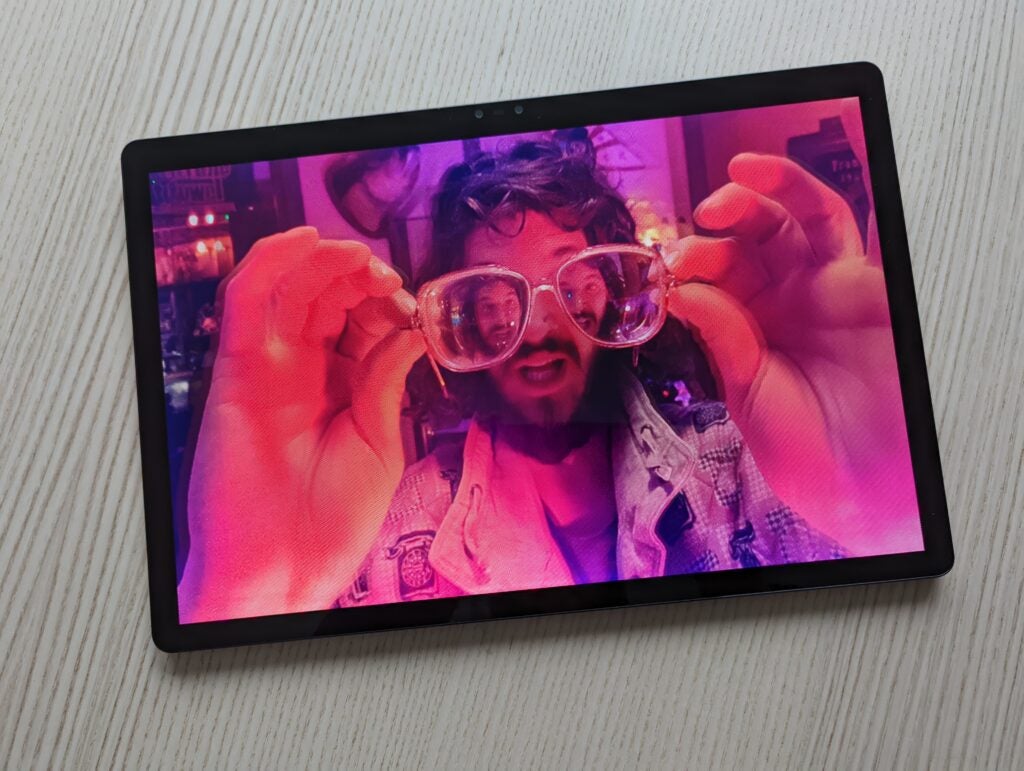
The 3D effects also work with video, with the tablet coming pre-installed with trailers of Minions, Justice League, Aqua Man and Jurassic Park to show off its talents.
I have to say, I’m not totally convinced by these 3D clips. When focusing on an on-screen character, they can look like a 2D cutout pasted on the forefront of an image, a bit like a pop-up book – it certainly doesn’t look as impressive as the 3D models you’ll see with Avatar: The Way of Water on a cinema screen.

And since the 3D video pushes the focused character or object to the forefront of the image, the background is then shoved to the back, appearing fuzzier and less detailed. For instance, I struggled to see the city backdrop when Ben Affleck’s Batman faces off against Superman in a clip of Dawn of Justice.
When watching busy scenes, with lots of particle effects and explosions, the 3D effects certainly look impressive, but it can also become overwhelming and confusing. Compared to a 2D image, it becomes substantially more unclear which part of the screen the film’s director intends for you to focus on.
I was personally more impressed with the 3D imagery when shooting my own photos and videos – and that’s no dig on James Cameron or Zack Snyder.
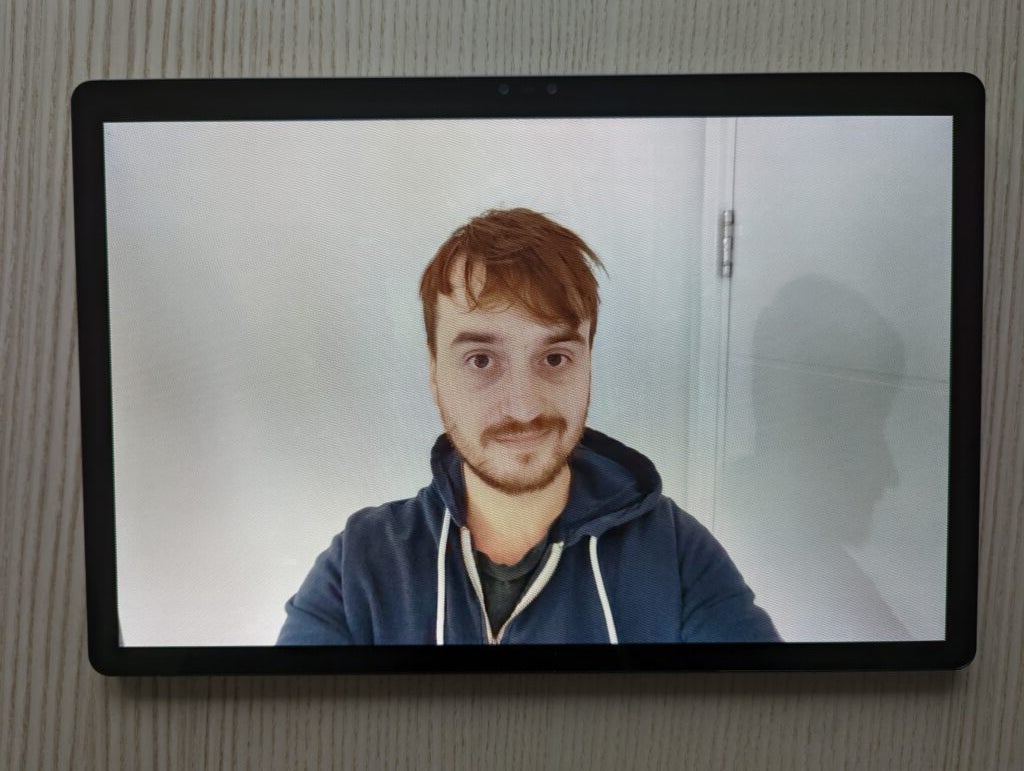
When taking a selfie with the Nubia Pad 3D, I marvelled at how it transformed my photo into a 3D image, with my head visibly popping out from the office background behind me. It’s unfortunately extremely difficult to capture this effect on camera for this preview, but trust me when I say it looks great.
The AI can even transform videos that you shoot into 3D, with the tablet being able to smartly decipher each object’s position and proximity to the camera in order to create an accurate depth of field of the room.
Unfortunately, you’re only able to view these photos and videos in 3D on the Nubia Pad 3D – post them onto social media or send them directly to a friend’s device, and they’ll look just like a standard 2D picture/video. This begs the question, what’s the point in making 3D media if nobody else can view them in that format?
Design and screen
- 12.4-inch screen with 120Hz refresh rate
- 16MP +16MP cameras on rear
- 4-speaker setup with Dolby Atmos support
The Nubia Pad 3D may have a lot of fancy tech stuffed inside, but that seemingly hasn’t significantly impacted the design. It’s a little thicker (8.4mm) and heavier (780g) than a 12.9-inch iPad Pro, although I still found it comfortable enough to hold with one hand.

The Nubia’s 12.4-inch screen is bold and colourful, with a 2560 x 1600 resolution to keep images suitably sharp. You’re limited to an LCD panel here rather than the more exciting OLED or Mini LED, although that’s understandable since most of the budget likely went on the 3D tech. You do at least get a 120Hz refresh rate to allow for fluid scrolling.
It has a rather basic design, with a black bezel surrounding the screen, and just two buttons up top for power and volume.
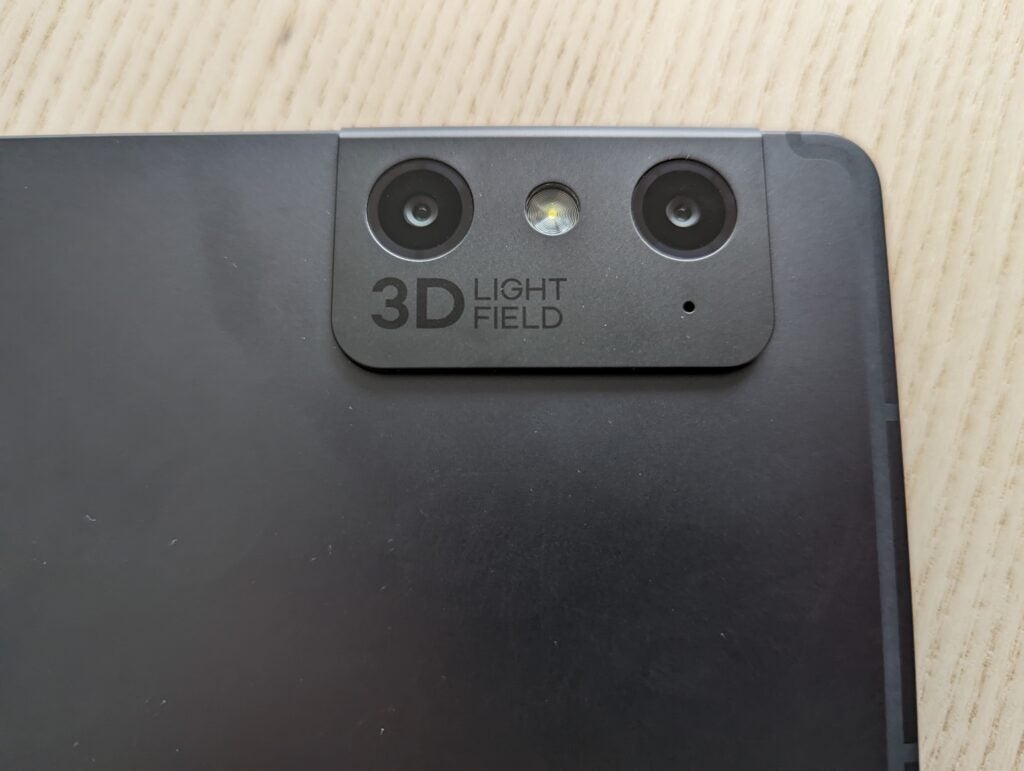
Flip the tablet over, and you’ll see a smooth metal casing as well as a double-camera array (16MP +16MP sensors) in the top-right corner. I would have appreciated a bit more flair to the design, but it certainly isn’t a bad looking tablet.
The Nubia Pad 3D has a USB-C port on the side for charging, and features a 4-speaker setup with support for Dolby Atmos. Audio quality is impressive for a tablet, although it’s a shame there’s no headphone jack for those yet to make a jump to Bluetooth headphones.
Performance and battery life
- Powered by Snapdragon 888 chip
- Runs on Android 12, with 3D apps pre-installed
- Packs a 9070mAh battery with fast charging support
The Nubia Pad 3D is powered by a Snapdragon 888 processor, which is a couple of generations behind the cutting edge at this point – another sign of cost cutting to make that 3D technology accessible.
But as a tablet for entertainment, that’s not going to be a problem. From my limited time with the tablet, it seemed to sail through apps with no problems at all.
We will need to conduct some benchmark tests and stress test it with more demanding applications for our final review to see how it fares against the competition, but my first impressions suggest the performance won’t be a weakness.
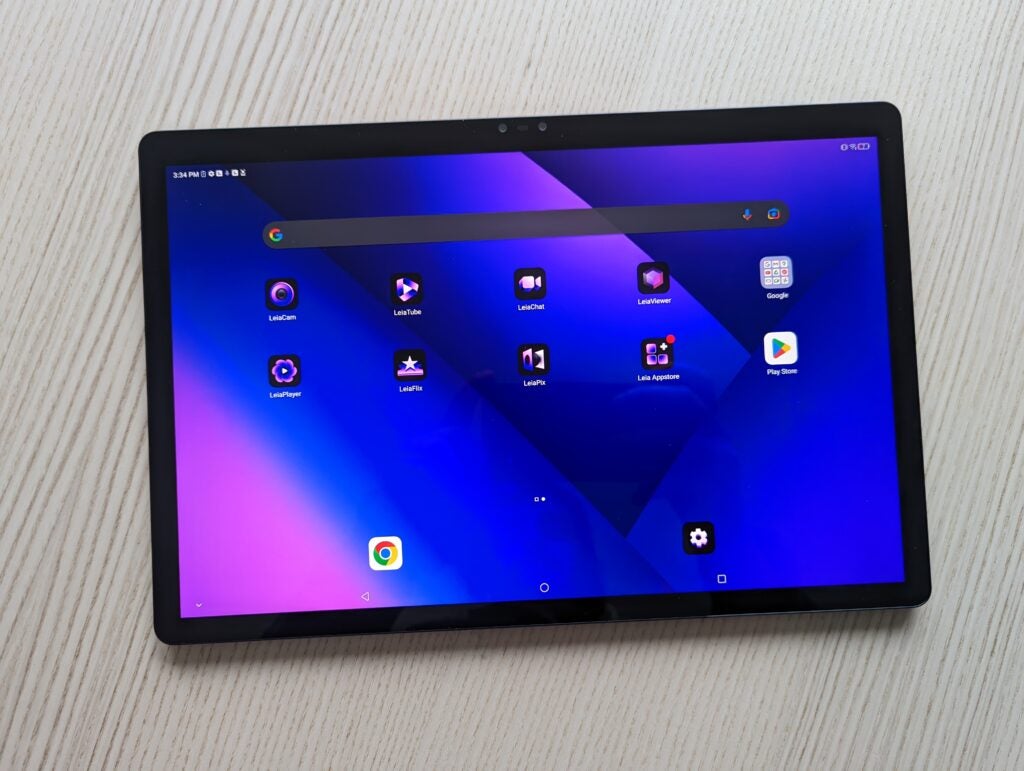
The Nubia Pad 3D runs on Android 12, with access to the Google PlayStore allowing you to install your favourite apps.
The Nubia comes pre-installed with apps which allow you to make the most of the 3D tech. One of those apps includes LeiaFlix!, featuring a library of 3D movies you can rent and stream from Warner Brothers and Universal Studios – unfortunately, this service is currently only available in the USA, and so I wasn’t able to try it out.
I do at least have access to the Leia Appstore, offering a library of apps that make use of the 3D technology, but that library is currently limited to a handful of apps. That’s really disappointing considering the 3D visuals is the main appeal of this tablet.

The tablet packs a 9070mAh battery, although we’re yet to test battery life to get an idea of longevity. Support for 33W fast charging should hopefully make recharges a speedy process.
Wireless connectivity is decent at Wi-Fi 6, although there’s no option for cellular connectivity if you had hopes you could browse the web and stream video via 5G.
Early Verdict
The Nubia Pad 3D has an impressive party trick with those 3D visuals, especially paired with the AI engine that can convert flat 2D images/videos into eye-popping 3D creations. It’s a great gadget to wow friends and family, but I’m not convinced it has much use beyond that, especially with the limited app library and inability to use LeiaFlix! outside of the USA.
Otherwise, the specs are decent enough with the Snapdragon 888 processor and 12.4-inch LCD panel, so it’s going to come down to the price (which has yet to be confirmed) whether the Nubia Pad 3D will be a worthy buy over an iPad or any other tablet.
FAQs
No, there’s no need for glasses, as the cameras are able to track your head and make sure the 3D image is positioned correctly.

